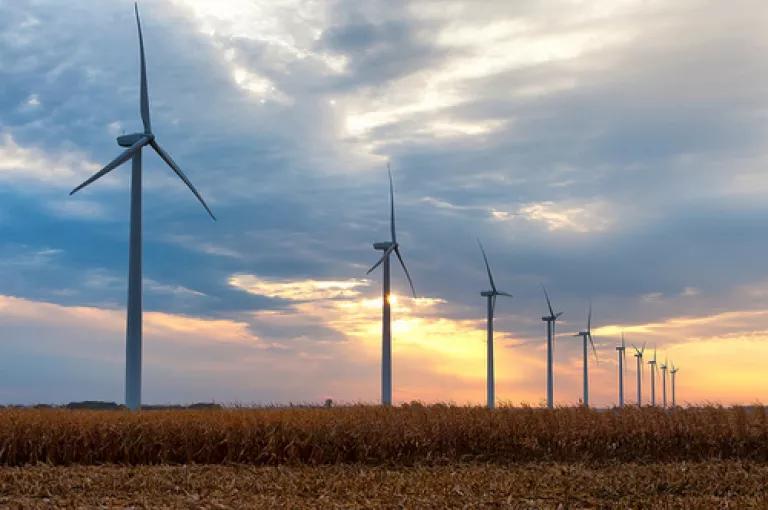
In Ohio lately, it seems we keep taking one step forward and two steps back. As other states harness the clean energy revolution, Ohio is bogged down by recent decisions that are holding back progress.
But a new report from the Ohio's Energy Future Tour, reflecting the voices of more than 10,000 Ohioans, confirms we can turn this around with the right combination of vision and leadership.
Ohio's Policies Are Holding the State Back
Ohio was thriving in the wake of SB 221. That policy--which was enacted with overwhelming bi-partisan support in 2008--sent Ohio down a clean energy path that would have ensured more efficient use of electricity and more renewables like wind and solar.
Thanks to SB 221, Ohio's utilities implemented wildly successful energy efficiency programs saving consumers billions of dollars, while at the same time rapidly carving out a renewable energy job market for the state.
... that is, until legislators enacted SB 310 last year, freezing clean energy efforts for two years and throwing all this progress in jeopardy.
Previously, Ohio was leading the country in the number of facilities manufacturing components for wind turbines, attracting billions of dollars in private clean energy investment into the state and breathing life into the fragile, recovering economy.
... that is, until an unprecedented property setback requirement was imposed on wind farms last year (HB 483), halting commercial-scale development in the state and making clear to investors that Ohio is not open for their business.
Earlier this summer, Amazon--which has a commitment to use renewable energy to power its facilities--announced its plans to locate a data center in central Ohio. Ohio was on track to benefit from this critical economic opportunity.
...that is, until Amazon opted to power its Ohio facility completely with wind from North Carolina rather than jumping through Ohio's energy policy hoops, sending even more jobs out of state.
Thankfully, all is not lost. Ohio has the opportunity to reverse these setbacks, and in the process maintain its position of leadership in the clean energy arena.
Ohio's Energy Future Can Begin Now--If We Do it Right
The Ohio's Energy Future Tour, a statewide series of forums, was created to provide an opportunity for citizens to give their thoughts on how Ohio's energy policy should look in the next few years and beyond. The forums also confirmed the positive impact that renewable energy and energy efficiency have had on economic development and quality of life in the Buckeye State.
The tour was organized by a broad, bipartisan coalition of businesses, local governments, environmental advocates (including NRDC) and trade associations--a coalition that reflects the scope of interest in these issues across the state.
Over the course of six meetings across the state, the tour traveled 726 miles and heard testimony from over 70 community and business leaders, health professionals, energy experts, elected officials, university faculty and staff, national security specialists and faith leaders.
Thousands of Ohioans participated in the forums, voicing their support both at the events, but also through a petition urging Ohio's leaders to embrace clean energy. To date, more than 10,000 citizens have added their names to the petition, demanding that legislators and the administration re-commit to a clean energy path.
Ohio's Energy Vision is Simple, Yet Effective: Commit to Clean Energy
Over the course of this journey, one thing became clear--Ohio's 21st century energy policy should embrace cleaner resources and technological innovation to benefit both businesses and the families who depend on affordable and safe power.
Ultimately, the goal is to deploy clean energy in a way that diversifies the state's portfolio, establishes market certainty, ensures reliability and affordability, transforms access to the grid, promotes sustainable communities, and leaves a healthy legacy for future generations.

But how do we get there?
It's actually simpler than you might think--Ohio is well-positioned to move forward because the state already has well-crafted energy policies in place, just waiting to be leveraged.
To transform the clean energy vision into a reality, Ohio's lawmakers should look to the energy efficiency and renewable policy tools already at our disposal and provide leadership at this critical time. Four key, achievable recommendations were culled from the hundreds of miles traveled on the tour and the thousands of Ohio voices heard:
-
Reinstate meaningful and required renewable energy and energy efficiency standards;
-
Develop a cost-effective state plan to meet U.S. EPA's recently-finalized Clean Power Plan to reduce carbon emissions from Ohio's electric power sector;
-
Increase distributed generation, aggregation and net metering opportunities;
-
Repeal the set-back requirements for wind farms.

Photo: Carl Wykoff on Flickr, under Creative Commons licensing.
The tour's final report comes at an important time for Ohio, as the state begins to roll up its sleeves to draft a plan for meeting U.S. EPA's rules to cut harmful carbon pollution from power plants. Ohio will also be determining later this month how it intends to proceed with energy efficiency and renewables. SB 310 established a committee to examine the clean energy policies and determine their fate, which remains uncertain. The committee is set to release a report on September 30 and may make recommendations on the future of Ohio's energy landscape, including whether these cost-saving energy efficiency and renewables efforts will continue to exist.
The state has so much to offer: natural resources, skilled workforce, robust manufacturing base, and world-class innovation. If we take the right steps now, Ohio will be on the road to securing low-cost power, adding critical local jobs to the economy, cutting harmful pollution emissions, and strengthening the electric grid for years to come.
Ohio achieved a position of leadership in the clean energy arena when it first enacted its clean energy policies. We should not relinquish that role at a time when other states in the region and across the nation are moving forward and surpassing us.
Implementing these policies now is critical to realizing Ohio's long-term energy vision. The longer we wait, the harder it will be to get back on track. But we can do it with the right combination of leadership, public policy and private action.
